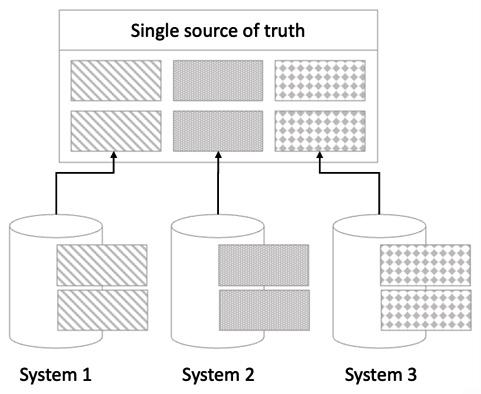Next up in our learning journey is Master Data Management (MDM). As part of the exam curriculum, you should be able to understand how to effectively design and implement an MDM strategy on the Salesforce platform, so we’ll cover what MDM is and how to implement it.
In addition, you will be able to articulate the concept of a golden record, so we’ll cover the background to this concept and some techniques for implementing it (because depending on the system landscape and what system is designated as the data master, the golden record may not necessarily be on the Salesforce platform).
We’ll then turn our attention to preserving data traceability across multiple data sources and understanding how this affects the context in which business rules run.
In this chapter, we’ll cover the following topics:
MDM is the discipline of determining and maintaining a single source of truth for shared data across an enterprise. As you can probably imagine, maintaining multiple copies of the same information across an IT enterprise is inefficient and can lead to data inconsistencies. Unless people and technology are 100% aligned, maintaining multiple copies of the same data is virtually impossible. Siloed businesses (where each business division is effectively separated in terms of people and technology) suffer from data inconsistencies, and the quality and classification of data they hold is often flawed. These scenarios require bringing together the data held by different systems into a data master, or single source of truth.
A single source of truth can be visualized conceptually as follows:

Figure 3.1 – Bringing data held in different systems to form a single source of truth
An example of inadequate MDM was realized by myself recently, and it involves my local car dealership. I enquired about, and ultimately purchased, a car from them, and as such, data about me and my purchased vehicle was on the sales team database. This is important to the dealership because they can send me reminders of when my car is due for a service and the like. Unfortunately for me, the dealership’s marketing department doesn’t have integration with the sales department, and as such, I continue to receive marketing emails from the dealership enticing me to purchase the car I already own.
This particular scenario happened because the car dealership departments have unconnected systems. I’m represented twice in the IT enterprise, as a prospect in one system and a qualified (and converted) sales lead in another. If the car dealership’s different departments’ data was centralized into a single source of truth, they could see that I had purchased a car, and perhaps turn their marketing efforts to upselling and cross-selling activities, such as deals on car accessories or a servicing package.
MDM should be an ongoing process, as part of a wider organizational data strategy. For example, when one organization acquires another organization, its data must be cleansed, de-duplicated, classified, and reconciled with that held by the acquiring organization. The benefits of consolidating data into a shared single source of truth ensure people in organizations are using the latest, cleansed, and correctly classified data. The single source of truth is often referred to as the golden record. We’ll cover this concept in the section titled The golden record, later in this chapter.
Let’s now cover some key terms used in MDM and their definitions.